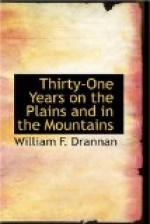We decided to take Sublet’s Cutoff, leaving Salt Lake City about one hundred miles south, as Jim said he would rather fight Indians than Mormons.
Six days after leaving Fort Bridger I met two of Gen. Connor’s scouts in Cash valley, and they told us the Utes were very bad farther West, and advised us to take the Goose Creek route to avoid the Indians. We took their advice.
Here was a scope of country that neither Jim nor I had ever been over, it being a new road just made the year previous.
After traveling four days on this road, late in the evening of the fourth, I discovered a little band of Indians about six or eight miles from the road on a stream that I have since heard called Raft river, which is a tributary of the Snake.
We watched the band until dark and then rode as near as we thought safe. I then left my horse with my two assistants and crawled up near the Indian camp and tried to get a count on them. When I got near them I found that they were Bannocks and were not warriors, but apparently a hunting and fishing party, and were an old men and women. I went away without molesting or even allowing them to know that I had been there.
Four days’ travel from here brought us into a section of country where I had done my first scouting, on the waters of the Humboldt. The first day after striking the Humboldt, three of my men and I late in the afternoon, ran on to a small band of Utes, eleven in number. I thought we had discovered them and got away without being noticed, so I told the boys that by making a circuit of about one and a half miles we would have the advantage of the ground and would be on to them before they knew it.
On arriving at the place where I expected to make the charge I was disappointed to find that they were mounted and on the move, they having no doubt gotten sight of us when we first saw them. We gave chase but they had too far the start of us, and after running about two miles we ended the pursuit.
There was no more trouble until we got to where Wadsworth now stands. Here, one morning about sunrise, as the herders were bringing in the stock, five Indians rushed in and tried to stampede the animals, but the herders happened to see them in time to give the alarm. Jim and I having our horses tied near the camp, were out after them quicker than I can tell it. We got two of them, and I think the other three must have thought themselves extremely lucky that they got away with their scalps.
The only damage done by them was that they scared the herders out of a year’s growth, and just where those Indians came from I never have been able to tell, for I made it a rule to circle the camp every evening and look for Indians and Indian signs.
This was the only time on the trip that I had an Indian steal a march on me, and this was the last trouble we had with Indians on this trip. Ten days travel brought us to the foot of the Sierra Nevada Mountains at the head of Eagle Valley.




